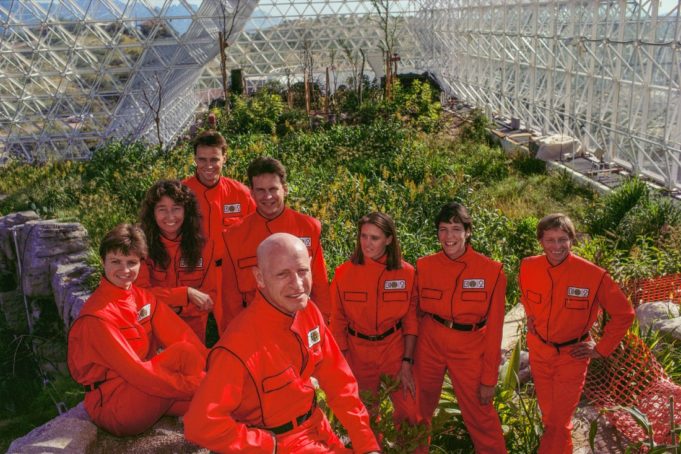I was a teenager in Arizona when eight scientists sequestered themselves in Biosphere 2, a geodesic dome in the desert outside Tucson containing an environment intended to be a self-contained, self-sustaining support system for a group of scientists for two years. The mission’s failures quickly became the subjects of jokes, and its cultural legacy has been reduced to a bad Pauly Shore movie. (I hear all of you under 30 asking, “What’s that?”) However, since all of us have spent the spring quarantined in our own indoor environments, now is a fortuitous time to revisit this grand experiment in a documentary called Spaceship Earth, which hits Grand Berry Theater’s streaming platform along with fellow Neon documentary The Painter and the Thief this week.
A relic of the 1990s, Biosphere 2 had its roots in the ’60s as the brainchild of John Allen, an Oklahoma farmboy with an MBA from Harvard, an interest in theater, and a flair for salesmanship. At a time when the world worried about nuclear war, he identified global warming as the main threat to human civilization and resolved to address it in a way that combined his love for business, the arts, and science. A charismatic leader, he recruited a group of hippies and actors to build a commune in New Mexico and then a boat in Oakland. Despite his acolytes’ utter lack of training, they built a seagoing vessel that sailed around the world. (DIY shipbuilding — kinda makes your small-batch whiskey and your herb garden look small.) His brainwave in the 1980s was that a self-contained biosphere under a dome would be an excellent dry run for astronauts needing to do the same for long-distance space travel. This piqued the interest of his main investor, none other than Fort Worth’s Ed Bass. I’m ashamed not to have known this.
Director Matt Wolf comes fresh off Recorder: The Marion Stokes Project, a documentary from last year that I liked. He interviews Allen and numerous crew members who lived in the habitat starting in 1991. Tony Burgess, the University of Arizona professor who designed Biosphere 2’s artificial desert environment, provides a bolt of truth when addressing the accusations that Allen had a cult-like hold over the project and its employees. He says, “Innovative startups always feel like cults. Human beings are wired to form cults.” I found that one plausible enough to be chilled thoroughly. Ironically, it was Burgess who told Bass and Biosphere’s board some time into the project that he believed Allen was suffering paranoid delusions and compared him to an abusive parent.
I wish Wolf hadn’t glossed over the technical flaws that beset Biosphere 2, or let his interview subjects gloss over them. It would be nice to know why the carbon dioxide levels in the dome suddenly spiked to the point of posing a danger to the people inside. The bionauts maintain that the CO₂ scrubber inside was only removing a small amount of carbon dioxide, but if that’s the case, why have it at all? Allen told both the press and his investors that the experiment would likely fail, but that the lessons learned would benefit future iterations and pave the way for eventual success. Knowing this, the project managers probably shouldn’t have publicized the experiment with a huge burst of press (Biosphere’s informational video boasted appearances by Tom Cruise and Meryl Streep) that left its one-woman publicity department overwhelmed. Granted, a $200 million project — the equivalent of $375 million today — is hard to keep under wraps, but Allen and company overpromised what they could deliver at the start and then hid things from the press when they started to go wrong.
A panel of outside scientists commissioned to advise Biosphere on how to fix their problems was riven by internal bickering, with several members angling for Bass’ money themselves. A trove of scientific data from the experiment was lost in its aftermath, and the film points its finger at human death’s-head figure Steve Bannon, brought in by Bass to be the project’s CEO once the scientists were out. That’s a nice detail, but Wolf lets pass without comment a 1991 journalist’s description of the Biosphere crew as “ethnically diverse.” You’re probably looking at the photo accompanying this review and thinking, “Really?”
In the end, the main bug of Biosphere wasn’t hubris but old-fashioned personality conflicts, both under the dome and outside it. Allen did not take it well when the project began to slip from his control, but a Hollywood director could have told him that for this size investment, there will be people looking over your shoulder. For all the shortcomings of Biosphere, Spaceship Earth (named after a book by R. Buckminster Fuller, whose geodesic dome design also played into Biosphere) shows how much these intrepid terraformers accomplished despite everything. To them, spending years in space and forming colonies on Mars and planets further out wasn’t a pipe dream but something they expected in their lifetimes. The same was true for the investors, who had some understandable misgivings about Allen, who wrote a play for his scientists to perform the night before they went under the glass. Too few of our tech people are willing to bring other disciplines to bear on their work or think about how we could broaden our horizons. The film is a tribute to the entrepreneurial spirit, one that flags sometimes but never truly goes out.
Directed by Matt Wolf. Not rated.












